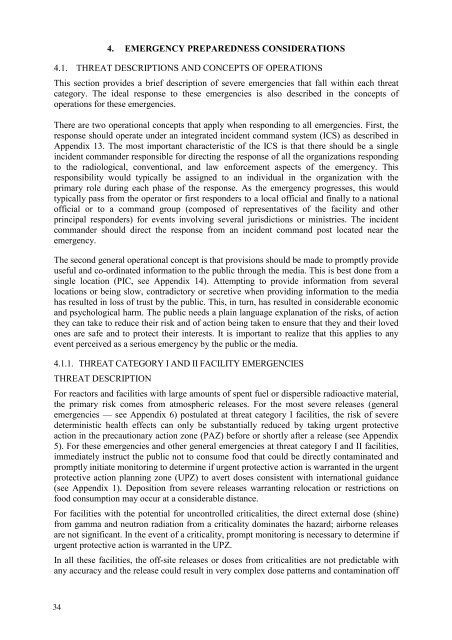epr-method (2003) - IAEA Publications - International Atomic Energy ...
epr-method (2003) - IAEA Publications - International Atomic Energy ...
epr-method (2003) - IAEA Publications - International Atomic Energy ...
You also want an ePaper? Increase the reach of your titles
YUMPU automatically turns print PDFs into web optimized ePapers that Google loves.
4. EMERGENCY PREPAREDNESS CONSIDERATIONS<br />
4.1. THREAT DESCRIPTIONS AND CONCEPTS OF OPERATIONS<br />
This section provides a brief description of severe emergencies that fall within each threat<br />
category. The ideal response to these emergencies is also described in the concepts of<br />
operations for these emergencies.<br />
There are two operational concepts that apply when responding to all emergencies. First, the<br />
response should operate under an integrated incident command system (ICS) as described in<br />
Appendix 13. The most important characteristic of the ICS is that there should be a single<br />
incident commander responsible for directing the response of all the organizations responding<br />
to the radiological, conventional, and law enforcement aspects of the emergency. This<br />
responsibility would typically be assigned to an individual in the organization with the<br />
primary role during each phase of the response. As the emergency progresses, this would<br />
typically pass from the operator or first responders to a local official and finally to a national<br />
official or to a command group (composed of r<strong>epr</strong>esentatives of the facility and other<br />
principal responders) for events involving several jurisdictions or ministries. The incident<br />
commander should direct the response from an incident command post located near the<br />
emergency.<br />
The second general operational concept is that provisions should be made to promptly provide<br />
useful and co-ordinated information to the public through the media. This is best done from a<br />
single location (PIC, see Appendix 14). Attempting to provide information from several<br />
locations or being slow, contradictory or secretive when providing information to the media<br />
has resulted in loss of trust by the public. This, in turn, has resulted in considerable economic<br />
and psychological harm. The public needs a plain language explanation of the risks, of action<br />
they can take to reduce their risk and of action being taken to ensure that they and their loved<br />
ones are safe and to protect their interests. It is important to realize that this applies to any<br />
event perceived as a serious emergency by the public or the media.<br />
4.1.1. THREAT CATEGORY I AND II FACILITY EMERGENCIES<br />
THREAT DESCRIPTION<br />
For reactors and facilities with large amounts of spent fuel or dispersible radioactive material,<br />
the primary risk comes from atmospheric releases. For the most severe releases (general<br />
emergencies — see Appendix 6) postulated at threat category I facilities, the risk of severe<br />
deterministic health effects can only be substantially reduced by taking urgent protective<br />
action in the precautionary action zone (PAZ) before or shortly after a release (see Appendix<br />
5). For these emergencies and other general emergencies at threat category I and II facilities,<br />
immediately instruct the public not to consume food that could be directly contaminated and<br />
promptly initiate monitoring to determine if urgent protective action is warranted in the urgent<br />
protective action planning zone (UPZ) to avert doses consistent with international guidance<br />
(see Appendix 1). Deposition from severe releases warranting relocation or restrictions on<br />
food consumption may occur at a considerable distance.<br />
For facilities with the potential for uncontrolled criticalities, the direct external dose (shine)<br />
from gamma and neutron radiation from a criticality dominates the hazard; airborne releases<br />
are not significant. In the event of a criticality, prompt monitoring is necessary to determine if<br />
urgent protective action is warranted in the UPZ.<br />
In all these facilities, the off-site releases or doses from criticalities are not predictable with<br />
any accuracy and the release could result in very complex dose patterns and contamination off<br />
34

















